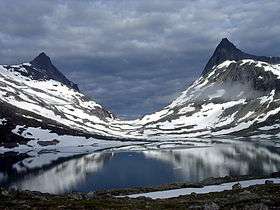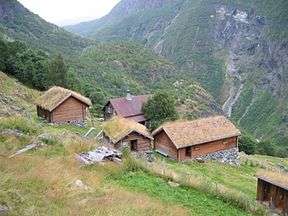Årdal
| Årdal kommune | |||
|---|---|---|---|
| Municipality | |||
|
Øvre Årdal in early-June 2008 | |||
| |||
 Årdal within Sogn og Fjordane | |||
| Coordinates: 61°17′29″N 07°47′53″E / 61.29139°N 7.79806°ECoordinates: 61°17′29″N 07°47′53″E / 61.29139°N 7.79806°E | |||
| Country | Norway | ||
| County | Sogn og Fjordane | ||
| District | Sogn | ||
| Administrative centre | Årdalstangen | ||
| Government | |||
| • Mayor (2002) | Arild Ingar Lægreid (Ap) | ||
| Area | |||
| • Total | 976.58 km2 (377.06 sq mi) | ||
| • Land | 930.12 km2 (359.12 sq mi) | ||
| • Water | 46.46 km2 (17.94 sq mi) | ||
| Area rank | 108 in Norway | ||
| Population (2014) | |||
| • Total | 5,496 | ||
| • Rank | 189 in Norway | ||
| • Density | 5.9/km2 (15/sq mi) | ||
| • Change (10 years) | -2.4 % | ||
| Demonym(s) | Årdøl[1] | ||
| Time zone | CET (UTC+1) | ||
| • Summer (DST) | CEST (UTC+2) | ||
| ISO 3166 code | NO-1424 | ||
| Official language form | Nynorsk | ||
| Website |
www | ||
|
| |||
Årdal is a municipality in Sogn og Fjordane county, Norway. It is located at the end of the Årdalsfjorden in the traditional district of Sogn. The village of Årdalstangen is the administrative center of the municipality. The other main village is Øvre Årdal. The municipality of Årdal was created in 1860 when it was separated from the municipality of Lærdal.
Årdal is a modern industrial community, with ties to the old society of farming and fishing. It is surrounded by dramatic nature with high mountains and waterfalls. The climate is rather mild and with less rain than normal in the west part of Norway. Årdal is a good starting point to explore the wild nature of Jotunheimen National Park, and with summer and winter activities within its boundaries. The Vettisfossen waterfall (highest in Norway) is located within the municipality.[2]
Name

The Old Norse form of the name was Árdalr. The first element is the genitive case of á which means "river" (referring to the Utla river) and the last element is dalr which means "valley" or "dale". Until 1921, the name was written Aardal.[3]
History
Lærdal was established as a municipality on 1 January 1838 (see formannskapsdistrikt). The original municipality was identical to the Lærdal parish (prestegjeld) including the sub-parish (sokn) of Aardal. In 1863, the sub-parish of Aardal (population: 1,791) was separated from Lærdal and became a municipality of its own. The spelling was later changed to Årdal.
On 1 January 1964, the Muggeteigen, Luggenes, and Bergmål farms (population: 11) were transferred from Årdal to Lærdal.[4][5]
Establishment of center for asylum seekers
From 1 August 2013 to 1 September it received 151 asylum seekers.[6] (The municipal council had beforehand said no to establishing a center for asylum seekers, but the fylkesmannen resolved otherwise.[6]) On 4 November 2013, one of the residents of the center was found—with a knife in his hand—on the bus from Årdal to Oslo, together with one dead bus driver and two dead passengers. The incident is known as the Triple murder on the Valdres Express,[7] and only one male[8]—the asylum seeker—is a police suspect. Earlier on the same day, for the first time one of the center's asylum seekers was removed (by police) in order to be deported from Norway.[9] (After the deaths, media said that Norway has no requirement for screening the mental health of asylum seekers—unlike requirements in Netherlands.)
Coat of arms
The coat of arms is from modern times; they were granted on 9 August 1957. They are red with yellow zig-zag lines. The local economy at the time was mainly based on heavy industry, which needs a lot of electricity. The zig-zag lines in the arms symbolize both the electrical power and the industries. The colors were chosen randomly.[10]
Government
All municipalities in Norway, including Årdal, are responsible for primary education (through 10th grade), outpatient health services, senior citizen services, unemployment and other social services, zoning, economic development, and municipal roads. The municipality is governed by a municipal council of elected representatives, which in turn elect a mayor.
Municipal council
The municipal council (Kommunestyre) of Årdal is made up of 21 representatives that are elected to every four years. For 2011–2015, the party breakdown is as follows:[11]
| Party Name | Name in Norwegian | Number of representatives | |
|---|---|---|---|
| Labour Party | Arbeiderpartiet | 16 | |
| Progress Party | Framstegspartiet | 1 | |
| Conservative Party | Høgre | 1 | |
| Centre Party | Senterpartiet | 3 | |
| Total number of members: | 21 | ||
Mayor
The mayor (ordførar) of a municipality in Norway is a representative of the majority party of the municipal council who is elected to lead the council. Arild Ingar Lægreid of the Labour Party was re-elected mayor for the 2011–2015 term.[12]
Geography

The municipality is situated at the inner part of the Årdalsfjorden, one of the beginning branches of the Sognefjorden and is a gateway to the mountain areas called Jotunheimen and Hurrungane, including the mountains Falketind, Store Austanbotntind, and Store Skagastølstind.
There are two urban areas in Årdal: Årdalstangen and Øvre Årdal, with a total population of approximately 5,700. There are also smaller village areas throughout the municipality: Naddvik (Vikadalen), Nundalen, Indre Offerdal, Ytre Offerdal, Seimsdalen, Fardalen, Avdalen, Utladalen, Vetti, and Vettismorki.[2]
Årdal is bordered to the north and west by the municipality of Luster, to the east by Vang (in Oppland county), and to the south by Lærdal.
Industry
Årdal became a symbol of modern Norway after World War II. In the course of a few years, Årdal was transformed from a scarcely populated rural community into a small town situated around the aluminium plant Årdal og Sunndal Verk. Construction of the aluminium plant at Årdal started in 1941. The purpose was to build a large aluminium industry as a part of the German war effort. The Norwegian State confiscated the unfinished plant in Årdal in 1945 at the end of the war. The plant was finished by the government and production started in 1948.
At Årdal, the aluminium factory produced semi-finished aluminium that went on to be transformed into various products in other factories. During the early years most of the aluminium was exported. The car and airplane industries were big aluminium consumers. Some finished products were made in Norway, such as Høyang kitchen equipment, kettles, and pans.
In 1986, Årdal og Sunndal Verk was merged with Norsk Hydro under the name Hydro Aluminium AS.[13]
Churches
The Church of Norway has two parishes (sokn) within the municipality of Årdal. It is part of the Indre Sogn deanery in the Diocese of Bjørgvin.
| Parish (Sokn) | Church Name | Location of the Church | Year Built |
|---|---|---|---|
| Nedre Årdal | Årdal Church | Årdalstangen | 1867 |
| Øvre Årdal | Farnes Church | Øvre Årdal | 1970 |
Attractions
Utladalen
The Vettisfossen waterfall was given protected status in 1924. With a free fall of 275 metres (902 ft), it is the highest waterfall in Northern Europe.
The Vetti Gard og Turiststasjon, a farm rich in tradition dating from around 1120, is set in dramatic natural surroundings. The farm has been involved in tourism ever since the early 19th century and now serves as a café and tourist information office in the summer. The Vettismorki mountain farm is located nearby.
The Utladalen Landscape Protection Area (314 square kilometres or 121 square miles) was established in conjunction with the Jotunheimen National Park. It comprises large parts of the Utladalen valey and adjoining side valleys. The area contains several old farms and mountain pasture farmsteads of historical interest.
Utladalen Naturhus is a nature center situated at Skåri, an old farm. Farming here ceased in the early 1970s. In 1996 work commenced on the restoration of the old cultural landscape, and the Utladalen Naturhus center was opened in May 1998. Run by the Utladalen Naturhus foundation, the aim of the centre is to inform visitors about the natural and cultural history of Utladalen and Western Jotunheimen. The centre also includes the Slingsby Museum.[2]
Avdalen Gård (Farm)

The Avdalen farm is scenically situated on the mountainside above the beautiful Avdalen waterfall in the Utladalen valley. The land was cleared for farming in the 16th century. Abandoned in more recent times, the farm has now been restored to provide restaurant, accommodation and meeting facilities. The mill house can be seen in operation milling grain.[2]
Jotunheimen National Park
The Jotunheimen National Park, established in 1980, covers an area of approximately 1,145 square kilometres (442 sq mi) and comprises the Hurrungane, Fannaråki, and the Rauddalstind og Mjølkedalstind peaks. Jotunheimen is a popular area for hiking in summer and skiing in winter, and the Hurrungane massif is very popular with climbers.[2]
Indre Offerdal Museum
This old fjord-side settlement of Indre Offerdal "right down by the shore" is packed with interesting history about Årdal. Ten buildings, including a mill, sawmill, a shoreside warehouse, and farm buildings dating from the 19th century, provide insight into the beginnings of the extensive industrialization of this local community.[2]
Scenic Views
- Mountain Road from Årdal-Turtagrø: In the summer, this road from Øvre Årdal to Turtagrø links Årdal to the Sognefjell mountain road.[2]
- Folkevegen road from Hjelle-Vetti: From Vetti you can walk to Europe's highest waterfall (275 metres or 902 feet high). The road/path passes four waterfalls.[2]
Historical society
The group called Årdal Sogelag concerns itself with local history.
Transportation
One of the bus lines which stops there, is the Valdres Express which has an end stop in Oslo.
See also
References
- ↑ "Navn på steder og personer: Innbyggjarnamn" (in Norwegian). Språkrådet. Retrieved 2015-12-01.
- 1 2 3 4 5 6 7 8 "Welcome to Årdal". Årdal Kommune. 5 July 2004. Archived from the original on 2 January 2008. Retrieved 2008-06-24.
- ↑ Rygh, Oluf (1919). Norske gaardnavne: Nordre Bergenhus amt (in Norwegian) (12 ed.). Kristiania, Norge: W. C. Fabritius & sønners bogtrikkeri. p. 53.
- ↑ Jukvam, Dag (1999). "Historisk oversikt over endringer i kommune- og fylkesinndelingen" (PDF) (in Norwegian). Statistics Norway.
- ↑ Natvik, Oddvar (9 February 2005). "Some historical data on the 26 Kommunes". Retrieved 2008-06-24.
- 1 2 "Mottaksleder: – Alle har et ansvar for å hjelpe mennesker på flukt" [Leader of the center: - Everyone has a responsibility to help people on the run] (in Norwegian). NRK. 2013-09-12.
- ↑ Trippeldrapssikta blir avhøyrt torsdag Archived 4 March 2016 at the Wayback Machine.
- ↑ - Trippeldrapssiktet nektet avhør Archived 4 March 2016 at the Wayback Machine.
- ↑ Politiet må setje ned evalueringsutval etter bussdrapene Archived 4 January 2016 at the Wayback Machine.
- ↑ "Civic heraldry of Norway - Norske Kommunevåpen". Heraldry of the World. Retrieved 2014-02-25.
- ↑ "Members of the local councils, by party/electoral lists and municipality" (in Norwegian). Statistics Norway. 2011. Retrieved 2014-02-25.
- ↑ Årdal Kommune (12 August 2005). "Ordføraren" (in Norwegian). Retrieved 2008-06-24.
- ↑ Karlsen, Anne Marit. "Årdal Aluminium plant". Retrieved 2008-06-24.
External links
- Heimatt (Norwegian)
- Årdal kommune (Norwegian)
- Årdalsportalen (Norwegian)
- Tindevegen (Norwegian)
- Opplev Utladalen (Norwegian)
- Årdal Sogelag—a historical society (Norwegian)
- Avdalen farm in Utladalen (Norwegian)


